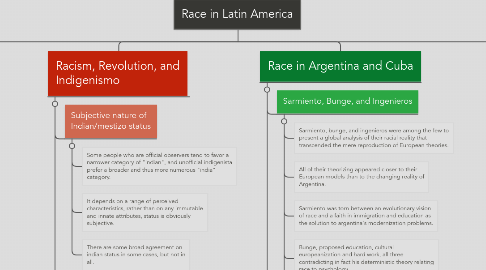
1. Race in latin America
1.1. Impact of French and Haitian Revolution
1.1.1. Douglas said that the blacks owed much to the American and British abolitionist and to the antislavery societies in various countries of the world. And that we also owe incomparably more to Haiti than to all of them.
1.1.2. Haiti was the "original pioneer emancipator of the 19th century."
1.2. Race in Haitian Revolution
1.2.1. Haitian revolution impinged on one way or another on the emancipation debate to outlaw African slave trade.
1.2.2. The haitian revolution showed blacks that liberation was a possibility in historical time.
1.3. U.S. and Haitian Revolutions
1.3.1. The Haitian Revolution created the second independent country in the Americas after the United States became independent in 1783.
1.3.2. U.S. political leaders, many of them slaveowners, reacted to the emergence of Haiti as a state borne out of a slave revolt with ambivalence, at times providing aid to put down the revolt, and, later in the revolution, providing support to Toussaint L’Ouverture’s forces.
1.3.3. Due to these shifts in policy and domestic concerns, the United States would not officially recognize Haitian independence until 1862.
1.3.4. When faced with the question of what the United States should do about the French colony of St. Domingue, Jefferson favored offering limited aid to suppress the revolt, but also suggested that the slaveowners should aim for a compromise similar to that Jamaican slaveholders made with communities of escaped slaves in 1739
2. Race in Argentina and Cuba
2.1. Sarmiento, Bunge, and Ingenieros
2.1.1. Sarmiento, bunge, and ingenieros were among the few to present a global analysis of their racial reality that transcended the mere reproduction of European theories.
2.1.2. All of their theorizing appeared closer to their European models than to the changing reality of Argentina.
2.1.3. Sarmiento was torn between an evolutionary vision of race and a faith in immigration and education as the solution to argentina's modernization problems.
2.1.4. Bunge, proposed education, cultural europeanization and hard work, all three contradicting in fact his deterministic theory relating race to psychology.
2.1.5. Ingenieros stood for evolutionism in Argentina and believed in the theory of "biogenetical correlation" between environment, climate, race, and beliefs.
2.2. Figueras and Ortiz Fernandez
2.2.1. Figueras tried to prove their racial incapacity to form an independent republic. He thought natural selection would eventually lead to the absorption of the blacks by the superior race, but it was a long term volition slowed by the persistence of an important nucleus of self reproducing blacks.
2.2.2. Both based their assertion on colonial and nineteenth century sources, perpetuated a negative image of the Afro-cuban.
2.3. Cuban Racial Policy
2.3.1. Two major concessions were made to nonwhites: the Constitution of 1901 gave them equality and universal male suffrage.
2.3.2. Many policies directly aimed at segregation blacks.
2.4. The Little War of 1912
2.4.1. Was a chapter in the "perpetual and implacable struggle between races" that could never mix.
2.4.2. They warned against any black rebellions and advocated the creation of a national secret police and militias based on the U.S model.
3. Racism, Revolution, and Indigenismo
3.1. Subjective nature of Indian/mestizo status
3.1.1. Some people who are official observers tend to favor a narrower category of "indian", and unofficial indigenista prefer a broader and thus more numerous "india" category.
3.1.2. It depends on a range of perceived characteristics, rather than on any immutable and innate attributes, status is obviously subjective.
3.1.3. There are some broad agreement on indian status in some cases, but not in all.
3.2. Definition of "Indian"
3.2.1. The word Indian was conceived by non-indians. They are socially defined, with race being used as a common but genetically unsound shorthand for ethnicity.
3.3. Indigenismo
3.3.1. Talked about how indigenismo came more easily to mexican elites than andean elites, for whom the threat of caste war and reversion to barbarism seems truly present.
3.3.2. It represented another non Indian formulation of the "indian problem", it was another construct, part of a long tradition stretching back to the conquest. Yes they did use indigenismo to end racism.
4. Racial Ideas and Social Policy in Brazil
4.1. Race and Miscegenation
4.1.1. Brazil received more African slaves than any other country in the Americas.
4.1.2. Its legacy is one of the most interesting but often misunderstood multiracial societies in the world.
4.1.3. Unlike the U.S, which is biracial structure, Brazil has long had a large mixed-raced intermediate category, which on U.S historian has seen as the key to understanding present-day Brazilian race relations.
4.2. Brazilian Intellectual
4.2.1. Brazilian elite came to accept an identifiable ideology of development. These were the years when the liberal ideology rapidly conquered the younger generation.
4.3. Whitening Thesis
4.3.1. Abolitionists did worry about the large, illiterate, unskilled mass represented by the slaves. The majority of liberal abolitionists, preferred to think about european immigrants as the solution to the post abolition labor problem.
4.3.2. Having rejected the straightforward theory of absolute biological differences, the abolitionists nonetheless believed in racial influences. The abolitionists, hoped to maximize the influence of the higher or more advanced civilization, meaning the white european.
4.3.3. The whitening thesis got unique support from Brazil from the widespread belief, later popularized by Gilberto Freyre, that the Portuguese enjoyed an uncanny ability to whiten the darker peoples with home they mixed.
